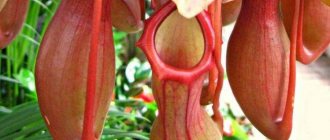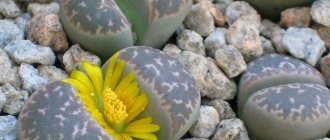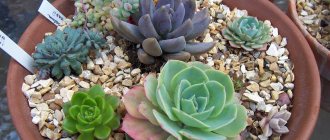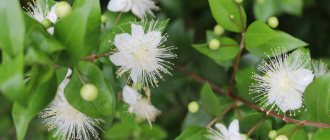Home » In the garden » Greens
Author Nonna Kravtsova Reading time 7 min Published 10/04/2014
When I first saw this plant, I thought it was a type of palm tree. Later I found out that this is a spurge, or rather a certain variety of this species, and I wanted to know what kind of care it needs at home, despite the fact that I didn’t have this plant yet. But I wanted to buy it so badly that I looked for any information about it. And after some time, this amazing flower finally appeared in my house.
Growing milkweed. The illustration for the article is used under the standard license ©delniesoveti.ru
At that time, I worked in a kindergarten and in the dark pool there was a white-veined euphorbia, so weak, since no one really looked after it in this dark place. In general, I decided to steal it, which is what I did. When I took him out of the kindergarten, my hands were shaking violently, since I had never taken anything like that without permission.
In general, there are many types of milkweed, and they are all attractive in their own way. There are euphorbias with and without thorns, and there are varieties with leaves. And all completely different plants have one common property. Each type of milkweed has a white sap inside the stem, similar to milk.
caring for your milkweed at home. The illustration for the article is taken from open sources
But it has nothing in common with milk; on the contrary, milkweed juice is poisonous. According to legends, the ancient Indians made poisoned arrows from milkweed juice. So, if you have small children, then consider purchasing this plant, or put it out of reach of children for a while.
There are types of milkweed that even bloom, but these flowers are not particularly beautiful; on the contrary, they are even inconspicuous.
Euphorbia grows very slowly at home, but if proper care is taken, the flower can grow up to two meters. In addition, milkweed is considered a long-liver.
Photos of indoor species of Europhobia
First, let's visualize what indoor varieties of this common plant look like.
Euphorbia Milii or Euphorbia milii - for its thorny stems it is often called the “crown of thorns”. In indoor floriculture, several varieties are known.
Euphorbia Mile
Euphorbia triangularis, or Euphorbia triangularis , got its name from the characteristic shape of its stems.
Euphorbia triangularis
White-veined milkweed or Euphorbia leuconeura is a plant with a ribbed stem and beautiful bright green leaves with white veins.
Euphorbia white-veined
Euphorbia tirucalli or Euphórbia tirucalli . It is also called rubber. The juice of this plant is very poisonous; you should not keep it in an apartment where there are small children.
Euphorbia tirucalli or Euphórbia tirucalli
Comb spurge or Euphórbia lophogona . It is also called ribbed. It is very popular in indoor floriculture and is found quite often, both in apartments and offices.
Euphorbia lophogona or Euphórbia lophogona
Euphorbia Pallas, Euphorbia multiflorum and Euphorbia fringe belong to garden varieties and are not grown indoors.
As you know, spurge is a succulent. This is a very large group and includes many interesting plants. On our website you can find detailed articles about such plants as Agave, Lithops and Echeveria.
Species diversity
The genus Euphorbia includes more than 2 thousand plants. Some of them grow outdoors, but there are also indoor species. The most commonly found as a house plant are:
- Euphorbia white-veined. The most common perennial species, resembling a palm tree. It has large oval leaves with pronounced white veins. The flowers of Milkweed are small and inconspicuous; after they wither, seeds appear in their place.
Euphorbia white-veined - Euphorbia Tirukalli is a perennial indoor flower. The peculiarity of this succulent is the complete absence of leaves. The entire flower consists of stick-stems sticking out in different directions. This species blooms rarely and only with proper care.
Euphorbia Tirukalli - Euphorbia triangular. It grows as a shrub with thick triangular shoots. On the dark green branches, light streaks and red-brown thorns are clearly visible. The leaves of Euphorbia triangular are very small and resemble a spatula.
Euphorbia triangular - Euphorbia Mile. A small shrub with a branched ribbed stem. Its top is framed by green ovoid leaves and small grouped flowers of scarlet, purple, lemon or orange.
Euphorbia Mile - Euphorbia obese. A perennial flower resembling a round cactus without thorns. It has almost invisible ribs. The diameter of Euphorbia Obese can reach 8 cm. Sometimes small flowers appear at the top of the plant.
Euphorbia obese
This is only a small part of all types of indoor euphorbia. All of them are not similar to each other and have a unique structure.
Transfer
A plant purchased in a store must be replanted if it is in a transport container. The flower will not be able to develop in the temporary container used for transporting plants.
An adult plant is replanted as it grows. It is advisable to replant in the spring . Many species of milkweed do not grow quickly, growing only a few inches throughout the year.
Transplanting milkweed
Euphorbia should not be planted in a pot that is too large, as too much soil can have a negative effect on the plant's growth.
What can cause harm
Most often, diseases occur due to improper care.
- The flower has begun to rot - most likely it is standing in a draft;
- The appearance of mold and falling leaves is a sign of lack of moisture.
Pests also often attack it: root or mealyworms, aphids, spider mites. All of them can cause yellowing leaves. To solve this problem, it is enough to purchase a special pest control product from a gardening store.
How to seat
Some types of milkweed, such as Milkweed, can be propagated by dividing the bush.
This should be done at the beginning of the spring or autumn period . The plant is taken out of the pot, the damaged parts of the rhizome are carefully removed and the stems and roots are divided into parts.
If, when dividing the roots, cutting them is required and you need to resort to using a sharp instrument, then you need to sterilize this instrument before use. Fresh root sections must be washed with warm water until the juice stops flowing out and sprinkled with charcoal.
Bush suitable for dividing
The separated parts of the bush should be planted in pots with a prepared drainage layer and special soil. This method of propagation is not an easy test for milkweed, so at first its development will not be intensive.
Flowering in the first year is unlikely . The plant will recover and begin to fully develop in about 2 years.
The main signs of malaria
It is impossible to give a definite description of the plants of the Euphorbia family, due to their absolute dissimilarity. The stem is usually erect, although some species have no stem at all. The leaves can be oblong, large or small, sometimes mixed with spines. Some types of milkweed are very similar to cacti and have a large number of needles instead of leaves, or, like succulents, have no foliage.
Many representatives of milkweeds do not bloom or the flowers look like tiny inflorescences surrounded by covering foliage. There are plants that bloom brightly and densely, some of them have an unusual spike-shaped inflorescence.
Choosing a pot
The shape of the pot for milkweed can be any , but it is important to choose a container with a certain ratio of parameters. The root system of milkweed is superficial, so it should be planted in a shallow but wide-diameter pot.
When the plant reaches a large size, when replanting, it is recommended to place heavy stones on the bottom to stabilize the position.
Euphorbia shoots are planted in a pot with a large layer of drainage and soil, which is a mixture of sand and leaf soil in a 2:1 ratio.
After planting, the soil needs to be moistened . During the growth period, the plant should be watered moderately, using settled warm water.
Excessive moisture should not be In winter, the frequency of watering is reduced to 2 times a month.
Plant Care Guide
Euphorbia is considered an undemanding plant, so even novice gardeners can care for and grow it. Many garden species of this plant tolerate winter well, remaining in the soil until spring. For the successful life of a flower, it is important to comply with two basic conditions:
- Protect spurge from drafts. Despite all the unpretentiousness of the flower, it does not tolerate drafts and can die if not maintained properly. Try to choose a secluded place on your windowsill if you are growing a flower at home.
- Ensure moderate watering of the plant. Excessive water can destroy the root system of a flower, so it is necessary to water it according to the season.
If you adhere to these nuances, then spurge will always delight you with its bright green color and flowering, if the selected species is capable of it.
Under favorable conditions, spurge blooms. And how!
Important: Whenever working with a flower, take precautions. Pricks from milkweed needles and thorns can be poisonous, and the sap causes burns. When interacting with the flower, wear gloves that will protect your skin.
Required lighting
Euphorbia is classified as a light-loving plant, so when growing it at home, it is worth determining the location of the flower on the south or southeast side. The flower tolerates even direct sunlight, but during the day it is still worth protecting the plant from excessive sun. Some species, such as “Mil”, “Palassa”, “white-leafed”, can get burned if the window is not shaded in the summer.
In winter, euphorbia needs additional lighting in the form of special ultraviolet light lamps.
Euphorbia will not die due to lack of sunlight, but if grown in the shade, its leaves will lose their rich green color and become dull.
Temperature
Euphorbia originally grew in hot countries, so the plant can safely be called heat-loving. Some types of milkweed can withstand severe cold temperatures down to +6 degrees. The temperature regime largely depends on the periods of rest and activity of the flower. For clarity, we present information about the temperature of milkweed in this table:
| Season | Temperature |
| Autumn winter | +10-15°С |
| Spring Summer | +20-25 °С |
The preferred temperature regime depends on the variety of milkweed, but minor temperature changes during the day do not adversely affect this flower.
Advice: If possible, in the summer you should take the flower out onto the loggia or into the garden. Fresh air, warmth and plenty of bright light will benefit milkweed.
Watering
For irrigation, the water should be settled in advance. The water should not be cold; it is preferable to water the spurge with warm water or at least at room temperature.
Moderate watering is very important for the plant, since excess water content in the soil will damage the root system of the flower. In summer, milkweed is watered once a week, and if the plant looks like a cactus, then once every two to three weeks. During particularly hot periods, spurge is sprayed if you planted the leafy variety. Before each subsequent watering, the soil should be dry. Excess water in the pan must be drained immediately. In winter, that is, during the dormant period of the flower, watering is reduced even more or stopped altogether.
Tip: If you forgot to stand the water in advance, you can simply boil it in a kettle and cool it. After this, water the flower. Another way out of this situation is to use a filter to purify water.
Humidity
Euphorbia tolerates dry climates well. The preferred air humidity for this plant is 40-50%. If your milkweed variety is similar to a cactus, then air humidity is not particularly important for it, but dry air remains the best option. This plant does not like abundant moisture, so it is recommended to remove dust from its leaves with a dry brush.
The soil
Soil for milkweed can be purchased ready-made in the store. Opt for soil for succulent plants. If you couldn’t find one, then soil for cacti is quite suitable. If you are not lucky enough to purchase a ready-made mixture for planting your plant, then you should prepare the future soil yourself. There are two main compositions of soil for milkweed:
- Mix leaf soil and sand in equal proportions. A third of the total mass should be humus. Move well. Leaf soil is loose soil that is formed as a result of humus of fallen leaves. Manure is often used as humus. You can buy it ready-made in the store.
- Another way to prepare soil for milkweed is to mix equal proportions of turf and sand.
Most often, a flower has to be replanted after purchase, so you need to find out about the soil and the rules for this process in advance.
Important: Do not forget about high-quality drainage for the flower. Place small pebbles or expanded clay at the bottom of the pot.
Transfer
It is advisable to replant the plant in the spring. This way the milkweed quickly adapts to new conditions and recovers as quickly as possible. What to do if you purchased milkweed at another time of year?
There are several situations when transplantation cannot be delayed until spring. Let's consider the following cases:
- Initially, you bought milkweed in a container not intended for subsequent cultivation. For example, this could be a shipping container.
- The soil that is in the pot after purchase contains growth stimulants, which means that it is not suitable for subsequent maintenance of the flower.
Euphorbia should be replanted very carefully, transferring it from one pot to another. The root system of these plants is very delicate, so rough handling can easily damage it. Let's consider a few basic rules for planting and replanting milkweed:
- It is better to carry out the procedure in the spring, during the growing season of the plant.
- The soil must be prepared in advance. If you are not sure about the quality of the soil, then water it with potassium permanganate before planting. This way you will carry out a small disinfection of the soil.
- Replanting must be done once every two years. Pay attention to the roots. If there is not enough room for the roots in the pot, then the plant needs to be replanted.
- After transplanting, the spurge should be watered with settled warm water.
Important: Do not forget about the drainage layer at the bottom of the pot. In its absence, the plant will rot.
Video on the topic:
Choosing a pot
For milkweed you need a deep pot, preferably with thick walls. When replanting, you should choose a pot two to three centimeters larger than the previous one.
Tip: Do not plant a plant in a pot “to grow,” that is, larger than necessary. This can cause rotting of the root system.
Top dressing
During the growing season, namely in spring and summer, milkweed needs feeding. You can buy this nutrient mixture at a succulent store or prepare it yourself. The recipe for homemade feeding for milkweed looks like this:
Mix leaf and garden soil, sand and brick chips in equal proportions. You can add a little birch charcoal.
In spring and summer, spurge is fed once every 2 weeks. In winter, fertilizing is not carried out, since the plant is dormant.
Tip: Do not use nitrogenous fertilizers for fertilizing. They can cause cracks in the stems of milkweed.
Plant pruning
Caring for milkweed also requires annual pruning. This procedure does not apply to all types of milkweed. The most commonly pruned euphorbias are “Mila” and “brilliant”. Pruning is done in mid-summer. Remove any dead stems and trim the tops to form a crown.
Tip: If you want your milkweed to look more well-groomed and bloom profusely, you should remove the shoots in late February or early March. Euphorbia will not bloom in summer, but next year it will become denser and bloom stronger than before.
Priming
For normal growth, spurge needs to be planted in loose soil with a mandatory drainage layer. To plant milkweed, you can use ready-made soil for succulents, or prepare it yourself.
Ready-made store-bought mixtures are dry, so it is recommended to add lowland peat to them.
To prepare the soil yourself, you will need to mix leaf soil, sand and humus in a ratio of 2:3:2. A mixture of sand and garden soil in equal proportions is also good.
Watch the video for all the pros and cons of different soils for succulents:
Planting milkweed
Before you begin planting or any other work with this plant, you must take safety measures in view of the toxicity of its milky sap. Euphorbia is distinguished by its low maintenance and ease of planting. If you plant it in open ground, you must choose an area open to sunlight or a slightly shaded area, with the exception of bordered milkweed. This variety prefers to grow in the shade, since bright sunlight is detrimental to the decorativeness of its foliage.
The plant does not tolerate excess moisture and acidity of the soil, so for planting it you need to choose a dry place, and acidified soils should be limed. The arrangement of high drainage, especially in places with clayey, poorly permeable soil, is mandatory.
Temperature
The optimal temperature for indoor milkweed is from 19 to 25 degrees Celsius.
In summer, it is possible for the plant to remain on the balcony at temperatures above 15 degrees Celsius, since euphorbia feels good in the open air.
Some types of milkweed can withstand temperatures up to +5 degrees Celsius.
Features of growing at home
All types have similar requirements. To grow a healthy crop, you will have to adhere to a number of rules:
- planting milkweed should be carried out in fertile soil;
- the crop needs bright, diffused lighting, so it is better to place the flower pot on the windowsill on the south-east or south-west side;
- the optimal temperature for cultivation during the period of active growth is +22-26°C; during the rest period – +10°C;
- dry air is preferable to humid air;
- It is not recommended to have a shower; dust should be brushed off with a brush.
Attention! Due to the fact that all parts of euphorbia are poisonous, all work must be carried out with gloves.
Bloom
Flowering is characterized by the appearance of small inflorescences at the bases of leaf blades. Euphorbia begins to bloom in April. The flowering process extends over the entire period of active development. In the winter season, if there is good lighting, flowers may also appear.
Annual flowering is not available to all types of euphorbia. For example, the flowering of Euphorbia largehorn or Euphorbia Tirukalli is a very rare occurrence in indoor conditions. Euphorbia Mila and Euphorbia beautiful bloom with ease every year.
If it does not bloom, the reasons should be sought in insufficient sunlight or overfeeding the plant with fertilizers.
Blooming milkweed Mila
Flowering milkweed ribbed
White-veined milkweed blooming
Flowering plants occupy a strong place in the hearts and homes of gardeners. Caring for them is not always easy, but if you know the basic rules you can achieve success. We have prepared for you a whole series of useful articles on this topic. Read all about Impatiens, Gerberas, Hydrangea.
Trimming
After euphorbia blooms, it is recommended to prune , which will rejuvenate the plant. To do this, you need to trim the elongated shoots and remove the dried stems.
Pruning milkweed to form a crown is done at the end of winter by cutting off shoots. After such pruning, spring flowering will not occur , but the formation of a dense crown of the plant will begin. As a result of this procedure, the next milkweed bloom will be abundant.
Reproduction
Reproduction of euphorbia at home is carried out in the following ways:
- seeds;
- cuttings;
- kids.
Let's look at each of them.
Seeds
For propagation from seeds, ripened seeds are collected from milkweed pods. Euphorbia seeds can be stored for a year in a regular paper envelope, although it is advisable to sow with fresh seeds that have recently ripened.
Milkweed Seeds
Before sowing, the seeds need to be soaked in warm water for exactly one day.
To prepare the soil, sand is mixed with peat and heated at high temperature in the oven. The soil is calcined for disinfection. After 24 hours, the seeds are deepened into the prepared soil, the soil is covered with a piece of plastic film and placed in a warm place.
Cuttings
Propagation by cuttings is recommended to be carried out in the autumn, since this period is the most favorable. For this method of propagation, shoots and leaves of milkweed are used.
The process of propagation by shoot includes the following steps:
- Cutting shoots up to 10 cm long.
- Removing the lowest leaves.
- Wash off the released juice from the cutting.
- Treating the cut area with charcoal.
- Planting in moist sand.
The plant planted in the ground is kept under a transparent jar or cap until it is completely rooted. Lighting should be moderate .
The process of propagation by cuttings consists of the following stages:
- Cutting a leaf with a cutting.
- Removing milky juice.
- Processing the cut with root.
- Planting in moist soil.
- Covering with plastic wrap.
Propagation by cuttings
After planting, it is necessary to regularly moisten the soil , and also ventilate once a day.
It should be remembered that milkweed juice is toxic. The propagation procedure by cuttings must be carried out using protective gloves to prevent the poisonous juice from coming into contact with the skin.
Reproduction by children can be carried out in euphorbias - “cacti”. These types of euphorbia are capable of producing daughter shoots, from which new plants can be grown.
Re-rooting or rejuvenating a plant
In addition to the fact that milkweed juice is poisonous, it also has beneficial properties. Read about the benefits and harms of milkweed here.
Diseases and problems
White plaque. An example of a spider mite!
Improper care of the plant can cause the appearance of parasites or disease. The main signs of disease or parasite damage in milkweed:
Example of healthy leavesThe leaves are yellow and fall off. This sign indicates insufficient lighting, excessive watering or low temperature. Drafts can also cause these deviations.
- Brown and black spots. This fact is a sign of a fungus. To eliminate it, spray the plant with fungicides.
- White plaque. This sign indicates a mealybug. These are small bugs that harm the plant. They are collected from milkweed by hand, and then the flower is treated with tincture of garlic, calendula or a soap solution with machine oil.
- Small black bugs. Most likely, the plant is affected by aphids. Treat spurge with infusion of garlic, onion or hogweed.
- The underside of the leaves has a white coating. This sign indicates the presence of a spider mite. You can remove it by wiping the leaves with alcohol or a soap solution.
- Bugs were found on the roots during transplantation. The plant is affected by root worms. In this case, the roots are watered with hot water. After transplantation, it is necessary to water the plant for a month with aktara.
Euphorbia, despite the large number of possible diseases, is rarely affected by pests. Compliance with the rules of plant care minimizes the occurrence of such deviations.











